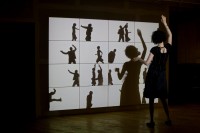SCOTT SNIBBE
Deep Walls
source: snibbe
Deep Walls is a projected cabinet of cinematic memories. When a person walks into its projection beam, the interactive wall starts recording his shadow, and the shadows of those who follow. When the last person leaves the frame, the shadows replay within one of sixteen small rectangular cupboards, looping indefinitely. Like structuralist films, the collection of repetitive videos becomes an object unto-itself, rather than strictly representational “movie.”
Deep Walls creates a complex temporal relationship between movie loops. Each small shadow-film has the precise duration of its recording: from a few seconds to several hours. The temporal relationship between the sixteen frames becomes complex—in a manner similar to Brian Eno’s tape loop experiments—looping individual recordings of different durations to create a composition that doesn’t repeat for days.
Deep Walls is inspired by the surrealist films of Jan Svankmajer and the Quay Brothers, and the sculpture of Joseph Cornell. In their films and sculptures, small bodies and obsessive collections of objects into cabinets and drawers represent psychological and spiritual states. The rational process of organization brings out an unconscious irrationality.
Deep Walls’ name is inspired by a design pattern from architect Christopher Alexander’s Pattern Language. He recommends building the walls of homes thick, so that the inhabitants themselves can carve out cabinets, drawers, and windows to personalize their homes. In the spirit of Alexander, this work gradually remembers the contents of its environment upon its surface.


